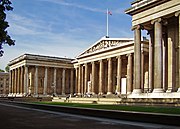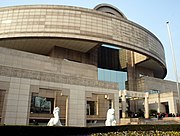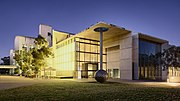Portal:Museums: Difference between revisions
MFD closed as keep (XFDcloser) |
Anomalocaris (talk | contribs) m properly close <div> |
||
| (5 intermediate revisions by 3 users not shown) | |||
| Line 1: | Line 1: | ||
| ⚫ | |||
| ⚫ | |||
| ⚫ | |||
{{Portal description}} |
|||
| ⚫ | |||
{{Portals browsebar}} |
{{Portals browsebar}} |
||
__NOTOC__ __NOEDITSECTION__ |
|||
<div style="clear:both; width:100%"> |
<div style="clear:both; width:100%"> |
||
{{Box-header colour| |
{{Box-header colour|<big>The Museums Portal</big>| colour= | mode= }} <!-- |
||
{{Portal image banner|}}--> |
{{Portal image banner|}}--> |
||
{{Transclude lead excerpt|Museums| paragraphs=1-2 | files=1}} |
{{Transclude lead excerpt|Museums| paragraphs=1-2 | files=1}} |
||
| Line 153: | Line 150: | ||
| File:Courtyard of the museum, 2014-12-05.jpg | Small cloister of the charterhouse of [[Santa Maria degli Angeli e dei Martiri]], built on the site of the [[Baths of Diocletian]]; part of the [[National Roman Museum]] of Rome |
| File:Courtyard of the museum, 2014-12-05.jpg | Small cloister of the charterhouse of [[Santa Maria degli Angeli e dei Martiri]], built on the site of the [[Baths of Diocletian]]; part of the [[National Roman Museum]] of Rome |
||
| File:Brama Arbeit Macht frei.jpg | Entrance to [[Auschwitz|Auschwitz I]], part of the [[Auschwitz-Birkenau Memorial and Museum]], a [[Holocaust]] museum on the site of the former [[Nazi concentration camps]] |
| File:Brama Arbeit Macht frei.jpg | Entrance to [[Auschwitz|Auschwitz I]], part of the [[Auschwitz-Birkenau Memorial and Museum]], a [[Holocaust]] museum on the site of the former [[Nazi concentration camps]] |
||
| File: |
| File:Yad Vashem View.jpg | Aerial view of [[Yad Vashem]], Jerusalem, Israel's [[Holocaust]] memorial; the museum, designed by [[Moshe Safdie]], opened in 2005 and tells the personal stories of ninety Holocaust victims and survivors |
||
| File:Air space exhibits 01.jpg | Now closed, the [[California Science Center|California Aerospace Museum]], designed by [[Frank Gehry]], formerly displayed a [[Lockheed F-104 Starfighter]] |
| File:Air space exhibits 01.jpg | Now closed, the [[California Science Center|California Aerospace Museum]], designed by [[Frank Gehry]], formerly displayed a [[Lockheed F-104 Starfighter]] |
||
| File:National Palace Museum Front View.jpg | [[Paifang]] or arched entrance of the Northern Branch of the [[National Palace Museum]], Taiwan, whose collection covers 8,000 years of the history of [[Chinese art]] |
| File:National Palace Museum Front View.jpg | [[Paifang]] or arched entrance of the Northern Branch of the [[National Palace Museum]], Taiwan, whose collection covers 8,000 years of the history of [[Chinese art]] |
||
| Line 280: | Line 277: | ||
{{Wikimedia for portals|species=no|voy=no}} |
{{Wikimedia for portals|species=no|voy=no}} |
||
{{Box-footer}} |
{{Box-footer}} |
||
</div> |
|||
</div> |
</div> |
||
{{Portal navbar no header2}} |
|||
{{portals}} |
|||
{{purge page}} |
{{purge page}} |
||
[[Category:Museums]] |
[[Category:Museums]] |
||
[[Category: |
[[Category:History portals]] |
||
Latest revision as of 06:03, 21 September 2021
A museum is an institution dedicated to displaying and/or preserving culturally or scientifically significant objects. Many museums have exhibitions of these objects on public display, and some have private collections that are used by researchers and specialists. Museums host a much wider range of objects than a library, and usually focus on a specific theme, such as the arts, science, natural history or local history. Public museums that host exhibitions and interactive demonstrations are often tourist attractions, and many attract large numbers of visitors from outside their host country, with the most visited museums in the world attracting millions of visitors annually.
Since the establishment of the earliest known museum in ancient times, museums have been associated with academia and the preservation of rare items. Museums originated as private collections of interesting items, and not until much later did the emphasis on educating the public take root. (Full article...)

The Centre Pompidou (French pronunciation: [sɑ̃tʁ pɔ̃pidu]), more fully the Centre national d'art et de culture Georges-Pompidou (lit. 'National Georges Pompidou Centre of Art and Culture'), also known as the Pompidou Centre in English, is a complex building in the Beaubourg area of the 4th arrondissement of Paris, near Les Halles, rue Montorgueil, and the Marais. It was designed in the style of high-tech architecture by the architectural team of Richard Rogers, Su Rogers, Renzo Piano, along with Gianfranco Franchini.
It houses the Bibliothèque publique d'information (Public Information Library), a vast public library; the Musée National d'Art Moderne, which is the largest museum for modern art in Europe; and IRCAM, a centre for music and acoustic research. Because of its location, the centre is known locally as Beaubourg (IPA: [bobuʁ]). It is named after Georges Pompidou, the President of France from 1969 to 1974 who commissioned the building, and was officially opened on 31 January 1977 by President Valéry Giscard d'Estaing.
The centre had 3.1 million visitors in 2022, a large increase from 2021 but still below 2019 levels, due to closings caused by the COVID pandemic. It has had more than 180 million visitors since 1977 and more than 5,209,678 visitors in 2013, including 3,746,899 for the museum.
The sculpture Horizontal by Alexander Calder, a free-standing mobile that is 7.6 m (25 ft) tall, was placed in front of the Centre Pompidou in 2012. (Full article...)
An art exhibition is traditionally the space in which art objects (in the most general sense) meet an audience. The exhibit is universally understood to be for some temporary period unless, as is occasionally true, it is stated to be a "permanent exhibition". In American English, they may be called "exhibit", "exposition" (the French word) or "show". In UK English, they are always called "exhibitions" or "shows", and an individual item in the show is an "exhibit".
Such expositions may present pictures, drawings, video, sound, installation, performance, interactive art, new media art or sculptures by individual artists, groups of artists or collections of a specific form of art. (Full article...)
- ... that the Paul Delvaux Museum exhibits not only Paul Delvaux's paintings, but also a collection of model trains?
- ... that the 2024 inductees to the Delaware Sports Museum and Hall of Fame include a man with Down syndrome who has lifted 425 pounds (193 kg), an "average gymnast" turned Olympics judge, a "preeminent sportswriter", the state's "greatest high hurdler", the "inventor" of the modern sports mascot, a record-setting 10-year-old, a champion gymnast, an Olympic field hockey player, and a pro baseball player in five countries?
- ... that the New Zealand stonefly Stenoperla prasina was the five millionth specimen digitised by the Natural History Museum in London?
- ... that Daniel Sickles's leg is a popular museum display?
- ... that the firm of Israel Sack supplied American antiques to leading private collectors and museums, including the Winterthur Museum, The Henry Ford, and the Metropolitan Museum of Art?
- ... that Ashton Hawkins arranged for the construction of the West Wing of the Metropolitan Museum of Art in New York City, to house the Temple of Dendur?
For editor resources and to collaborate with other editors on improving Wikipedia's Museums-related articles, see WikiProject Museums.

A ceramics museum is a museum wholly or largely devoted to ceramics, usually ceramic art. Its collections may also include glass and enamel, but typically concentrate on pottery, including porcelain. Most national collections are in a more general museum covering all of the arts, or just the decorative arts. However, there are a number of specialized ceramics museums, with some focusing on the ceramics of just one country, region or manufacturer. Others have international collections, which may be centered on ceramics from Europe or East Asia or have a more global emphasis.
Outstanding major ceramics collections in general museums include The Palace Museum, Beijing, with 340,000 pieces, and the National Palace Museum in Taipei city, Taiwan (25,000 pieces); both are mostly derived from the Chinese Imperial collection, and are almost entirely of pieces from China. In London, the Victoria and Albert Museum (over 75,000 pieces, mostly after 1400 CE) and British Museum (mostly before 1400 CE) have very strong international collections. The Metropolitan Museum of Art in New York and Freer Gallery of Art in Washington DC (12,000, all East Asian) have perhaps the best of the many fine collections in the large city museums of the United States. The Corning Museum of Glass, in Corning, New York, has more than 45,000 glass objects. (Full article...)
Lists
- Museums
- Most visited museums (by region)
- Art museums: most visited, largest
Types
- Art museum
- Agricultural museum
- Archaeology museum
- Architecture museum
- Artillery museum
- Aviation museum
- Biographical museum
- Cabinet of curiosities
- Ceramics museum
- Children's museum
- Community museum
- Computer museum
- Design museum
- Dime museum
- Ecomuseum
- Economuseum
- Ethnographic village
- Farm museum
- Fashion museum
- Folk museum
- Food museum
- Green museum
- Hair museum
- Hall of Memory
- Heritage centre
- Historic house museum
- Human rights museum
- Imaginarium
- Interpretation centre
- Jewish museum
- Lapidarium
- Lighthouse museum
- Living museum
- Local museum
- Maritime museum
- Migration museum
- Mobile museum
- Museum ship
- National history museum
- Natural history museum
- Open-air museum
- Palace museum
- Postal museum
- Prefectural museum
- Print room
- Private museum
- Regimental museum
- Schatzkammer
- Science fiction libraries and museums
- Science museum
- Sex museum
- Sculpture garden
- Technology museum
- Textile museum
- Torture museum
- Toy museum
- Transport museum (list)
- University museum
- Virtual museum
- Wax museum
- Writer's home
Related
The following Wikimedia Foundation sister projects provide more on this subject:
-
Commons
Free media repository -
Wikibooks
Free textbooks and manuals -
Wikidata
Free knowledge base -
Wikinews
Free-content news -
Wikiquote
Collection of quotations -
Wikisource
Free-content library -
Wikiversity
Free learning tools -
Wiktionary
Dictionary and thesaurus





































































